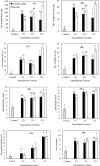Effect of biological sewage sludge and its derived biochar on accumulation of potentially toxic elements by corn (Zea mays L.)
- PMID: 38472316
- PMCID: PMC10933428
- DOI: 10.1038/s41598-024-56652-8
Effect of biological sewage sludge and its derived biochar on accumulation of potentially toxic elements by corn (Zea mays L.)
Abstract
The land application of sewage sludge can cause different environmental problems due to the high content of potentially toxic elements (PTEs). The objective of this study was to compare the effect of urban biological sewage sludge (i.e. the waste of activated sludge process) and its derived biochar as the soil amendments on the bioavailability of PTEs and their bioaccumulation by corn (Zea mays L.) under two months of greenhouse conditions. The soil was treated by adding biochar samples at 0 (control), 1, 3, 5% w/w. The diethylenetriamine pentaacetic acid (DTPA)-extractable concentrations of PTEs including Zn, Pb, Cd, Cr, Ni, Fe, and Cu in soil and their accumulation by plant shoot and root were measured. Conversion of the biological sewage sludge into the biochar led to decrease the PTEs bioavailability and consequently decreased their contents in plant tissues. The DTPA extractable metal concentrations of produced biochar in comparison to the biological sewage sludge reduced 75% (Cd), 65% (Cr), 79% (Ni and Pb), 76% (Zn), 91% (Cu) and 88% (Fe). Therefore, the content of Ni, Fe, Zn and Cd in corn shoot was decreased 61, 32, 18 and 17% respectively in application of 5% biochar than of raw sewage sludge. Furthermore, the application of 5% biochar enhanced the physiological parameters of the plants including shoot dry weight (twice) and wet weight (2.25 times), stem diameter (1.70 times), chlorophyll content (1.03 times) in comparison to using 5% raw sewage sludge. The results of the study highlight that application of the biochar derived from urban biological sewage sludge in soil could decrease the risk of PTEs to the plant.
Keywords: Bioavailability; Heavy metals; Risk; Soil contamination; Waste management.
© 2024. The Author(s).
Conflict of interest statement
The authors declare no competing interests.
Figures




References
-
- Tomczyk B, Siatecka A, Jędruchniewicz K, Sochacka A, Bogusz A, Oleszczuk P. Polycyclic aromatic hydrocarbons (PAHs) persistence, bioavailability and toxicity in sewage sludge- or sewage sludge-derived biochar-amended soil. Sci. Total Environ. 2020;747:141123. doi: 10.1016/j.scitotenv.2020.141123. - DOI - PubMed
-
- Tchobanoglous G, Burton FL, Stensel HD, Metcalf, Eddy I. Wastewater Engineering: Treatment and Reuse. McGraw-Hill Education; 2003.
-
- Hossain MK, Strezov V, Nelson PF. Comparative assessment of the effect of wastewater sludge biochar on growth, yield and metal bioaccumulation of cherry tomato. Pedosphere. 2015;25:680–685. doi: 10.1016/S1002-0160(15)30048-5. - DOI
MeSH terms
Substances
LinkOut - more resources
Full Text Sources

